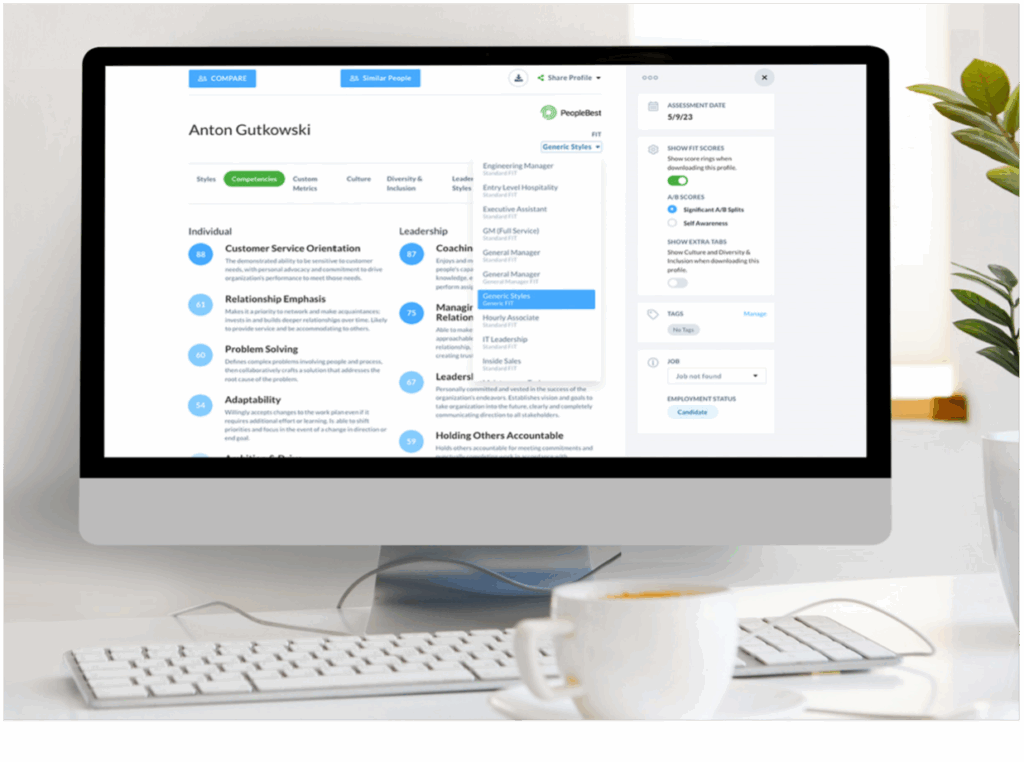Is the Résumé Dead (Part 2)
A couple weeks ago, I was really excited to share a blog called – Is the Résumé Dead. The topic is fascinating to me because my team and I are constantly working with big clients that use the most advanced Applicant Tracking Systems (ATS) in the world, especially in how they inbound and process resumes – and yet, they still need hiring help.
Confession, I was also patting myself on the back for a blog well done. I thought I had covered all the most important topics and felt like the blog itself could be helpful to you readers.
But then on September 4, 2023, just two days later, I came across a brilliant piece written by one Katherine Bindley entitled The New Recruitment Challenge: Filtering AI-Crafted Résumés. I started my day as I always do, with a coffee in and and popping online to the Wall Street Journal, only the best newspaper in the world, in my humble opinion, and there it was! I read through and I was blown away by the details and the perspective.
My first instinct was to STOP the presses on the blog I just wrote. And then I thought, why not just expand on it? The information in her piece was just too good for me not to include. I’ll tell you why in just a minute.
So fortunately, I have a great team that encouraged me by saying, “hey Jim, why not just publish the first one, and do a part two that is dedicated to this new information?” They convinced me that the first piece may provide my initial perspective and that this one could be dedicated to the nuances not covered in the first.
And so, here we are. Now, let’s get into WHY this is such a great read – and why I think Katherine Bindley deserves a tremendous amount of credit for the origination of some amazing content.
Bots Are Flooding Companies with AI-Generated Resumes
Katherine talks about how the use of generative AI to mass-produce résumés is overwhelming hiring systems, forcing companies to rethink their processes. Candidates are using AI tools to churn out résumés in rapid succession, sending out applications at a rate impossible without automation. What used to take hours or days is now done in minutes. Companies are receiving so many résumés that it’s clogging their hiring pipelines, leading recruiters to reinstate human review steps or even close job postings in less than 48 hours.
My Take: As I mentioned in my prior blog, with this surge of applications, most good candidates will be buried under a mountain of AI-generated résumés, never even making it to a hiring manager’s desk. It’s not just about finding the right person—it’s about whether you even get seen. If the first step in the hiring process is broken this badly, it doesn’t bode well for finding an authentic person, let alone one who is great for that role.
Fake Candidates Are Gaming the System—and Getting Hired
Katherine talks about the surge in fake candidates using AI to fake their way into roles is creating major hiring risks for companies. AI isn’t just making it easier to apply to jobs; it’s helping people fake experience, skills, and even entire identities. Candidates are lying on their résumés, using AI to inflate their experience or paying third parties to help them cheat their way through interviews. Some are even using software during Zoom calls to get real-time prompts or assistance, meaning companies are sometimes hiring candidates who can’t do the job they claim to be able to do.
My Take: This is a serious issue. Companies are wasting time and resources hiring people who aren’t qualified. Let me say that again – “Companies are wasting time and resources hiring people who aren’t qualified.” I can only imagine what kinds of massive liabilities this creates if they mismanage responsibilities, leading to costly mistakes, data breaches, or operational failures. This is where our clients use us to manage this challenge. No one can game a PeopleBest behavioral profile – and if you try, it shows up on the scores if you try.You get to know they are both ‘real’ and a great ‘FIT’ or not for the role. Sure, you can have someone else take a profile, but while you may get by this step, you’ll wash out when you get in the role. And we have yet to see this in our 20 years in business either.
Automation Is Filtering Out Real Talent
In this section, Katherine talks about how automated hiring tools are causing good candidates to be rejected before a human even sees their résumés. As she explains, for years, companies have used software to filter résumés, searching for specific keywords or qualifications to narrow down applicants. The problem? These systems are weeding out potentially great candidates who don’t use the right keywords or don’t tailor their résumés in a way that the software can detect. This creates a bottleneck, where real talent is bypassed for algorithmic efficiency.
My Take: Spot on. Here’s a cut & paste from my prior blog: “88% to 94% of recruiters believe ATS systems reject qualified candidates because their resumes lack the proper keywords or are not formatted correctly. Other sources cite that 75% of resumes are discarded due to readability issues. So, it seems like ATS’s are sifting out, in a very efficient manner, most everyone you’d want to hire.”
Hiring Managers Are Fighting Back with More Human Touchpoints
The big idea here is to combat these AI-driven issues, companies are adding more personal filters to the hiring process. Recognizing the flaws of purely AI-driven hiring processes, companies are beginning to add more human elements back into the mix. Recruiters are now asking candidates to complete personal questions or video recordings before their applications are considered. In some cases, they’re even adding live coding tests or asking candidates to explain their thought processes in interviews to weed out those hiding behind AI.
My Take: Finally, a good approach – but there are still lots of holes. The premise is that companies can’t rely solely on machines for something as human as hiring. Ok, fine. Technology may be great for scaling, but when it comes to finding the right talent, human judgment is also really flawed. If you’ve heard about the Halo effect, people are influenced immediately, either positively or negatively and this bias is all but etched into their perception of a candidate. We don’t seem to be talking about diversity anymore, but we were the best solution to looking at anyone in a completely unbiased way. We just looked at their behaviors as a match to the exact requirements in our clients jobs. Can you do the job or not? If yes, great. If not, both the person and the company would probably be miserable in cutting short where that person could be more successful.
Fake Résumés Lead to Real Business Risks
Here’s a huge point that Katherine hits on, the rise of fake résumés and applicants using AI tools is leading to disastrous hiring decisions. Recruiters are discovering that many candidates are faking entire résumés, claiming experience they don’t have and even getting hired for roles they can’t perform. Some companies only realize the deception after weeks or months when the employee fails to meet expectations—or worse, when they cause damage through incompetence.
My Take: This is just scary. We do see a LOT of resumes and will say there’s not a super high correlation of what they’ve done compared with whether or not they will be successful in a potential role. Even WITH using our clients exact, customized job profile. Why? Because each job is unique, because each company is unique. Some of the basics, like organization or creativity can be easily matched, but I’m talking about achieving OKR’s, KPI’s, changing a dynamic such as a team that either needs to be motivated or replaced, in part or in whole. Completely different challenges within a completely different culture. We can absolutely answer any of these unique questions and that’s exactly why our clients love us…!
Candidates Are Relying on ChatGPT—But Not Fooling Anyone
Lastly, Katerine talks about candidates who use AI tools like ChatGPT for coding tests and interviews are facing increased scrutiny. She explains that while some companies allow applicants to use tools like ChatGPT to help with coding tasks, they’re not letting it go unnoticed. Candidates are required to explain the tools they used, show their work in real-time, and justify their thought process. Companies are making sure that candidates know how to do the work.
My Take: I think this is a great idea. AI is here. Useful if managed. The use of AI in applications and interviews is reaching a critical point. If companies put safeguards in place to ensure they hire people who can think for themselves, great! I will say I see companies all day long that are or have filled roles with people who can talk the talk but can’t walk the walk, leading to poor performance, wasted time, and a hit to innovation, let alone a huge hit to the bottom line in the millions.
My final Take
I owe Katherine Bindley a huge ‘Thank You’ for her nailing her research, insights and professional insights in this article. I’m driven by helping find success inside of people, teams and companies. We can either use technology for good or harm. History gives us many examples of this too often. I believe we are up to these challenges, each one. Tools are just that. The tools that were supposed to streamline hiring are now the same ones that are clogging the system with fake candidates, overwhelmed hiring funnels, and unqualified hires. We can figure this out and have been for the last decade.
By focusing on authenticity, understanding the inside of the person with their strengths and corresponding weaknesses, thorough vetting, companies can fix their internal systems and add better AI-driven hiring solutions making sure they find the right person for the right job, not just the person who knows how to game the system.
I found there is a podcast from Katherine today: How AI Is Helping ‘Fake Candidates’ Land Jobs which Katherine and her colleagues share even more insights. Fantastic stuff – a MUST listen. Thank you again, Ms. Bindley!
Write to Katherine Bindley at [email protected]
Write to Jim Hunter at [email protected]















